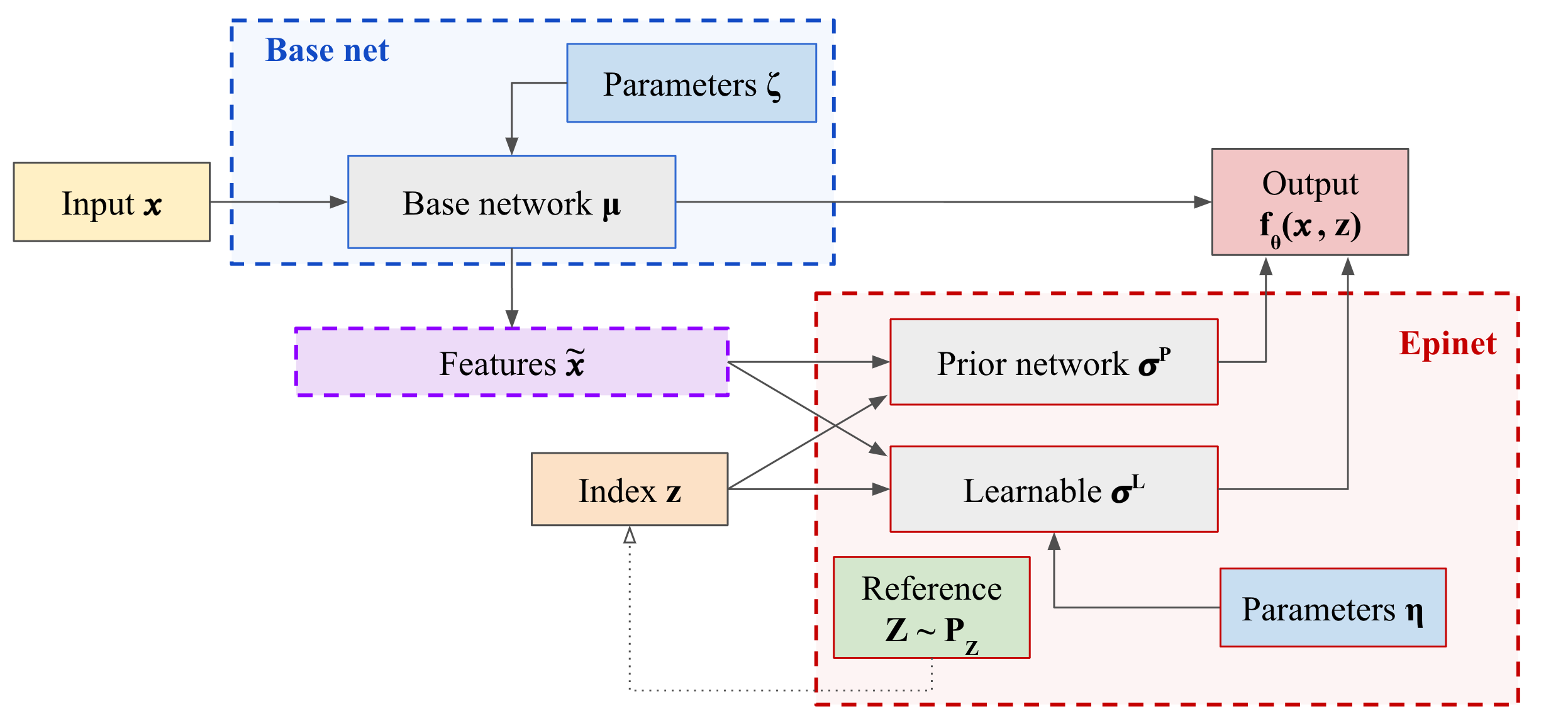A library for neural networks that know what they don't know.
For background information, please see the paper
Conventional neural networks generate marginal predictions: given one input, they predict one label. If a neural network outputs probability 50:50 it remains unclear if that is because of genuine ambiguity in the input, or just because the neural network has insufficient training data. These two possibilities would be distinguished by joint predictions: given multiple inputs, predict multiple labels.
An epistemic neural network (ENN) makes predictions given a single input x, but also an epistemic index z.
The ENN controls the index z and uses it to produce joint predictions over multiple inputs x_1,..,x_t which may be different from just the product of marginals.
An ENN provides a general interface for thinking about uncertainty estimation in deep learning. Note that, all existing approaches to uncertainty modeling, such as Bayesian neural networks (BNNs), can be expressed as ENNs. However, there are ENN architectures that are not natural to express and BNNs. This library provides interfaces and tools for the design and training of ENNs.
The
ennlibrary provides a lightweight interface for ENNs implemented on top of JAX and Haiku. If you want to use ourennlibrary, we highly recommend you start by familiarizing yourself with these libraries first.
We outline the key high-level interfaces for our code in base.py:
EpistemicNetwork: a convenient pairing of Haiku transformed + index sampler.apply: haiku-style apply function taking `params, x, z -> f_params(x,z)``init: haiku-style init function takingkey, x, z -> params_initindexer: generates a sample from the reference index distribution takingkey -> z.
LossFn: Given an ENN, parameters, and data: how to compute a loss.- Takes:
enn, params, batch, key - Outputs:
loss, metrics
- Takes:
We then use these high-level concepts to build and train ENNs.
You can get started in our colab tutorial without installing anything on your machine.
We have tested ENN on Python 3.7. To install the dependencies:
-
Optional: We recommend using a Python virtual environment to manage your dependencies, so as not to clobber your system installation:
python3 -m venv enn source enn/bin/activate pip install --upgrade pip setuptools -
Install
ENNdirectly from github:pip install git+https://github.com/deepmind/enn
-
Test that you can load
ENNby training a simple ensemble ENN.from enn.loggers import TerminalLogger from enn import losses from enn import networks from enn import supervised from enn.supervised import regression_data import optax # A small dummy dataset dataset = regression_data.make_dataset() # Logger logger = TerminalLogger('supervised_regression') # ENN enn = networks.MLPEnsembleMatchedPrior( output_sizes=[50, 50, 1], num_ensemble=10, ) # Loss loss_fn = losses.average_single_index_loss( single_loss=losses.L2LossWithBootstrap(), num_index_samples=10 ) # Optimizer optimizer = optax.adam(1e-3) # Train the experiment experiment = supervised.Experiment( enn, loss_fn, optimizer, dataset, seed=0, logger=logger) experiment.train(FLAGS.num_batch)
-
Optional: run the tests by executing
./test.shfrom ENN root directory.
One of the key contributions of our paper is the epinet: a new ENN architecture that can supplement any conventional NN and be trained to estimate uncertainty.
An epinet is a neural network with privileged access to inputs and outputs of activation units in the base network.
A subset of these inputs and outputs, denoted by
We can visualize this network architecture:
As part of our release include an epinet colab that loads in a pre-trained base network and epinet on ImageNet. The core network logic for epinet is available in networks/epinet.
If you use ENN in your work, please cite the accompanying paper:
@article{osband2022epistemic,
title={Epistemic neural networks},
author={Osband, Ian and Wen, Zheng and Asghari, Seyed Mohammad and Dwaracherla, Vikranth and Ibrahimi, Morteza and Lu, Xiuyuan and Van Roy, Benjamin},
journal={arXiv preprint arXiv:2107.08924},
year={2022}
}

